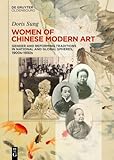Women of Chinese Modern Art : Gender and Reforming Traditions in National and Global Spheres, 1900s–1930s / Doris Sung.
Material type: TextPublisher: München ; Wien : De Gruyter Oldenbourg, [2023]Copyright date: ©2024Description: 1 online resource (XVIII, 292 p.)Content type:
TextPublisher: München ; Wien : De Gruyter Oldenbourg, [2023]Copyright date: ©2024Description: 1 online resource (XVIII, 292 p.)Content type: - 9783110798517
- 9783110799026
- 9783110798920
- 700.820951 23/eng/20240209
- NX583.A1 S86 2024
- online - DeGruyter
- Issued also in print.
| Item type | Current library | Call number | URL | Status | Notes | Barcode | |
|---|---|---|---|---|---|---|---|
 eBook
eBook
|
Biblioteca "Angelicum" Pont. Univ. S.Tommaso d'Aquino Nuvola online | online - DeGruyter (Browse shelf(Opens below)) | Online access | Not for loan (Accesso limitato) | Accesso per gli utenti autorizzati / Access for authorized users | (dgr)9783110798920 |
Frontmatter -- Contents -- List of Illustrations -- Acknowledgements -- Notes on Names and Translation -- Introduction: Locating the Woman Artist -- Part One: The Artist-Embroiderer -- Chapter 1 A Female Embroiderer in the Qing Court -- Chapter 2 From Nantong to the World -- Chapter 3 Discourses on Embroidery -- Part Two: The New Female Scholar-Painters -- Chapter 4 Family, Lineage, and Learning -- Chapter 5 Art and Scholarship -- Chapter 6 Professional Networks and Global Experience -- Part Three: The New Talented Women -- Chapter 7 An All-Women Collective -- Chapter 8 Exhibitions and Critiques -- Chapter 9 Artists, Philanthropists, and Educators -- Conclusion -- Appendix A Chinese and Japanese Characters for Names and Terms -- Appendix B Relations of Key Figures -- Appendix C Jin Family Lineage Chart -- Bibliography -- Index
restricted access online access with authorization star
http://purl.org/coar/access_right/c_16ec
Bringing to light the largely overlooked female participation in domestic and international art worlds, this book offers the first comprehensive study of how women embroiderers, traditionalist calligraphers and painters, including Shen Shou, Wu Xingfen, Jin Taotao, and members of Chinese Women’s Society of Calligraphy and Painting, shaped the terrain of the modern art world and gender positioning during China’s important moments of social-cultural transformation from empire to republic. Drawing on a wealth of previously unexhibited artworks, rare artist’s monographs, women’s journals, personal narratives, diaries, and catalogs of international expositions, Doris Sung not only affirms women’s significant roles as guardian and innovator of traditionalist art forms for a modern nation, but she also reveals their contribution to cultural diplomacy and revaluation of Chinese artistic heritage on the international stage in the early twentieth century.
Issued also in print.
Mode of access: Internet via World Wide Web.
In English.
Description based on online resource; title from PDF title page (publisher's Web site, viewed 06. Mrz 2024)


